#also its a epithet of artemis hekate and persephone
Explore tagged Tumblr posts
Text
Working on researching more obscure non-Attic Ancient Greek religion be like:
Me: Which deity was worshipped most in this region
Google: a Goddess who was not named but used this title, Despoine, in the mystery tradition, later conflated with these other goddesses from these other mysteries
Me: Yeh but who was the original goddess, before the conflations
Google: Bitch I just said it was a mystery didn't I?
#despoine#arkadia#arcadia#ancient greek religion#greek mysteries#arkadian mysteries#she was a sister of persephone at first not equated#also its a epithet of artemis hekate and persephone#demeter was her mom#void post
24 notes
·
View notes
Text
hekate: a history
hihi!! recently my friend expressed interest in learning more about hekate and I thought that I could do some research and put it into a post. I have an altar to her but I don't necessarily commune with her often, and I didnt know as much of her lore as I probably should've. let me know if there's another deity yall would like me to do another deep dive on. i will link the sources that i used at the very end!

Domain: magic, witchcraft, the night, the moon, ghosts, crossroads, boundaries, herbalism and necromancy. she ruled over sky, earth, and sea, and was often venerated as a part of the household deities. she is widely respected and revered, even by the other gods
Parentage: Perses, titan of destruction and known for his great wisdom; Asteria, titaness of falling stars and nighttime divination
Important Imagery:
-she is often depicted holding two torches, a key, a dagger, or snakes -her familiars include a dog--the Queen Hecuba who committed suicide or was received as Odysseus' consort after the fall of Troy--and a polecat (like a ferret)--or the midwife Galinthias who was transformed by the goddess Eileithyia -she was often given three heads or three bodies -her arrival is often preceded by the howling of dogs -she is sometimes shown flanked by lions or (multiple) dogs -in some depictions she will have an animal head, including anything from a cow, dog, boar, serpent, or horse -wheels and caves
Associated Offerings: garlic, cypress, oak, aconite, belladonna, dittany, mandrake, yew
Other Offerings: the typical historical offerings like myrrh and frankincense, wine, and barley. eggs or eggshells (cleansing, protection), black salt (protection from spirits), chocolate (underworld), coffee (underworld), lavender or cedar or sage (cleansing, magic), asphodel (underworld), black pepper (banishing, protection), camphor (dreams, psychic divination), clove (exorcism, wealth). evil eyes if its not cultural appropriation for you to use them. then of course keys, mirrors, bones, imagery of deceased, triquetra, jewelry or magic items like
Crystals: obsidian, smokey quartz, black tourmaline, black moonstone, lapis lazuli, amethyst, labradorite, jaspers (especially dalmation or star), howlite, opal, angelite, celestite, lepidolite, larimar, aventurine, citrine, malachite, jade, blue calcite, gems, gold/silver
Associated Holiday: Hekate's Deipnon (which I covered in my last post)
Lore:
-In Hesiod's Theogony he describes Hekate allying with Zeus against the Titans and how "Zeus the son of Kronos (Cronus) honored [her] above all. He gave her splendid gifts, to have a share of the earth and the unfruitful sea." -In the Homeric Hymns Hekate is described as a close companion of Persephone, as she (along with Hermes) helped deliver her back to Demeter after her capture by Hades -During the Deipnon she is said to lead the souls of the restless dead out of Hades during the night and must be placated with offerings -Hekate is also seen as a kourotrophos (probably because of her association with Eileithyia and Artemis), or protector of children, and is often invoked as such -Hekate is often seen as Medea's (from Jason and the Argonauts) patroness and the one who advised her of what to do to get over Aeetes' trials -Sometimes she is considered the mother of Circe and Medea
Epithets: (used like a surname to call upon her different aspects)
-Perseis: destroyer (after her father) -Aionios: eternal, ever-flowing -Apotropaia: the one that protects -Brimo: angry, terrible one -Indalimos: the beautiful -Aidonaia/Chthonia: of the underworld -Propolos: who serves -Soteira: savior -Trimorphis: three-formed -Trioditis: off the cross roads/three-way -Enodia: of the way/road -Propulaia: before the gate -Nyktipolos: night wandering -Phosphoros: light bringing -Atalos: tender, delicate -Kourotrophos: nurse of the young -Skylakagetis: leader of the dogs -Kleidouchos: holder of keys (of Hades) -Liparokredemnos: bright-coiffed -Anassa eneroi: queen of those below
Things That Are Probably Neopagan But I Can't Tell:
-Hekate being seen as a maiden-mother-crone triple goddess -Hekate's wheel symbol


Sources:
theoi.com
wikipedia on hekate
wikipedia on the deipnon
wikipedia on kourotrophos
some ancient greek holidays
hekate: a history
#hellenic deities#hellenic pagan#hellenic polytheism#hellenic worship#hellenism#helpol#ancient greece#ancient greek#chthonic deities#greek gods#hellenic paganism#hekate#greek deities#greek mythology#ancient greek mythology#pagan witch#paganism#pagan#paganblr#pagan community#altar#deity#deity work#deity worship#deities#hecate#witch community#witchblr#witchcraft#witches
118 notes
·
View notes
Text
Hecate: falsehoods and myths
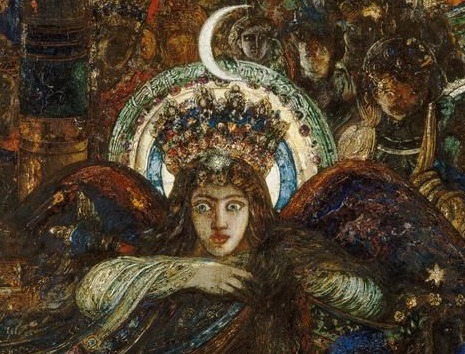
While my blog generally focuses on China and Japan, occasionally other topics related to religion and mythology warrant a post too. Due to Halloween being right around the corner, I decided to finally cover something I've been meaning to for a long while – the large number of misinterpreted, misreported or outright made up information about my favorite minor figure from Greek mythology, Hecate. While only rarely present in myths, she's a mainstay of not only popculture, but also of what I think warrants being called “pop-spirituality”. Under the cut I will examine a number of claims commonly seen online, and provide both the necessary debunks as well as some interesting genuine information.
Falsehood #1: Hecate's three bodies represent the neopagan virgin, mother, crone trinity This claim, as baffling as it is, made its way even to a number of academic publications – what prompted me to write this post was in fact stumbling upon it in a paper about a completely unrelated topic. In truth, there wasn't even such a thing as an universal “virgin-mother-crone” trinity in Greek mythology – the whole idea is a product of dubious 20th century scholarship, mostly that of Robert Graves, a man whose notable deeds include writing a number of seemingly entertaining historical novels, cheating on his wife with his “muses” (some of them teenaged), and introducing the world to a wide array of myths and interpretations he came up with himself, but presented as genuine (he want as far as lament that more credible authors refuse to spread his ideas further). The most prominent of them, outlined in his book White Goddess, was his belief in the existence of some form of universal goddess figure with three aspects, which he himself named rather inconsistently, and which he claimed corresponded to the phases on the moon. What is true is that Hecate was associated with the moon from the Hellenic period onward, with neoplatonic writers in particular highlighting this affinity. This appears to be derived from Hecate's role as a “light-bringing” deity, frequently depicted with torches in art. Her arguably most prominent appearance in a myth presents her as Persephone's guide on the way back to her mother, lighting the way through the underworld. A shift from a general light-bringing role to just an association with the moon likely occurred due to conflation occuring between Hecate and Artemis – however in earlier times she was also frequently associated with Apollo, who even held the title of “Hecaton” in some sanctuaries. It has also been suggested that originally the connection was based on Apollo being depicted as a “builder” deity, while Hecate's principal role was that of a guardian of homes, gates and roads, which made their purposes overlap. Due to the aforementioned moon connection, combined with the fact she was commonly depicted with three bodies in art, Hecate became a postergirl for Graves' theory. Of course, this association has no foundation in reality – Hecate is not described as triplicate in Hesiod's Theogony, the oldest source mentioning this goddess.
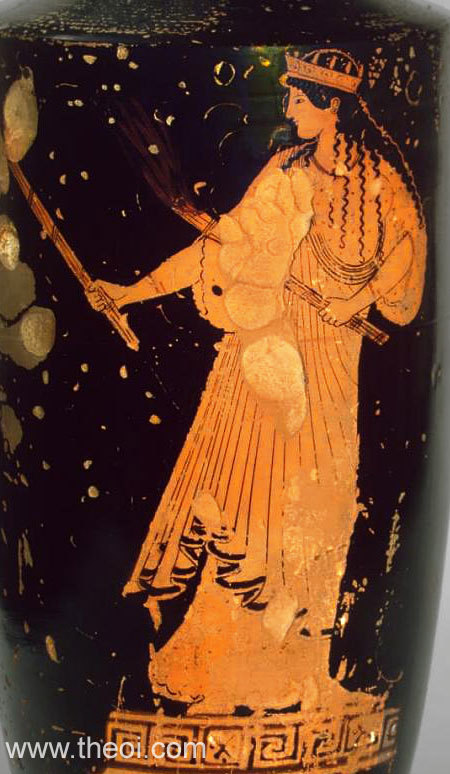
The oldest known depictions, both sculptures and pottery decorations, likewise depict her with only one body. Some later sources seemingly discussed the three bodied version as merely an art motif. Pausanias's travelogue presents the three bodied Hecate statues as an invention of the sculptor Alcamenes, and contrasts them with a single-bodied depiction: Within the enclosure [in Aegina] is a temple; its wooden image is the work of Myron, and it has one face and one body. It was Alkamenes, in my opinion, who first made three images of Hekate attached to one another, a figure called by the Athenians Epipurgidia [on the tower] It should be noted that yet other sources consider them to have religious importance as guardians of crossroads, though these claims are obviously not contradictory. Additionally, a few pieces of art, such as the Pergamon altar, depict Hecate with three bodies despite presenting myths in which she only possessed one.

Hecate was consistently portrayed as a young woman (some pieces of art, like the one above, depicted her in an Artemis-like manner, in a knee length garment) and with some small exceptions, usually relying on conflation with various nymphs, ancient Greeks seemingly considered her a virgin goddess. There are no widely agreed upon ideas regarding any other figures being regarded as Hecate's children, and even after becoming only a distantly remembered boogeyman she was not depicted as an elderly woman. Falsehood #2: a “pan-european” set of “witchcraft traditions” was derived from Hecate Most claims online related to witchcraft try to add a degree of complexity to what was senseless violence caused by moral panics, not dissimilar from the 1980s satanic panic. There was no “pan-european” component to them (beyond all instances of large scale witch hunts being motivated by religious fervor, of course), and in particular the worship of Hecate was neither extant at the time associated with witch hunts and the development of the modern western image of a witch, nor was it ever “pan-european”. If anything, an argument can be made that outside Greece and Anatolia, Hecate was more of a popular import in the east than in the west. Some Roman sources present the existence of Hecate household altars in Greece as a puzzling curiosity, which further strengthens this impression. The late version of her cult, presenting her as a witchcraft goddess spread to Egypt and Mesopotamia, while an older, more positive image of Hecate seemingly survived in far off Bactria. as evidenced for example by Agathocles’ coins with Zeus holding Hecate, seen below.
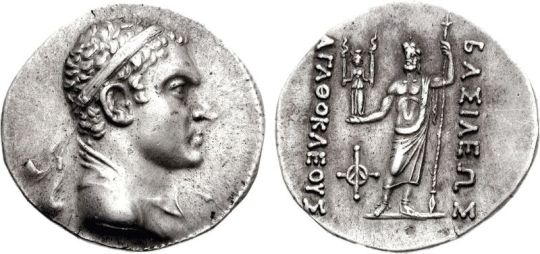
Neither version ever spread to western or northern Europe, though, and pretty clearly it did not survive in any form into the middle ages and beyond. Wikipedia mentions a truly outlandish modern association between Hecate and germanic wild hunt folklore, which strikes me as completely random. An actual well documented example of Hecate syncretism with a figure from outside Greek mythology involved the Mesopotamian underworld goddess Ereshkigal, however.
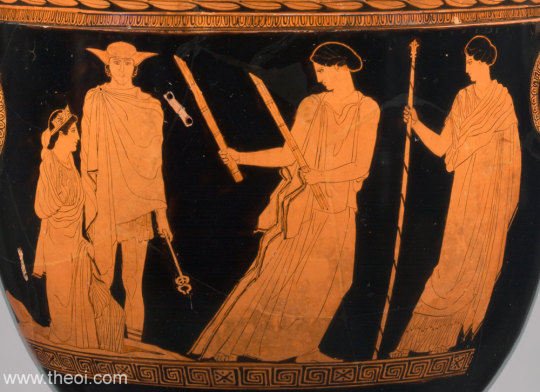
What's rather curious is that the very concept of Hecate as a witchcraft and underworld goddess might have been a relatively late development, and as such not an accurate representation her original character – and even in antiquity it wasn't an universally embraced association. Earliest Greek accounts of Hecate cast her in a positive, benevolent role. In the Theogony she's a titan siding with the Olympians and then aiding them during gigantomachia as well; in certain versions of the Persephone myth, for example in the Homeric Hymn to Demeter, she's an ally of Demeter offering her counsel and finally escorting Persephone back to her mother. Many of her epithets also point at a benign character.
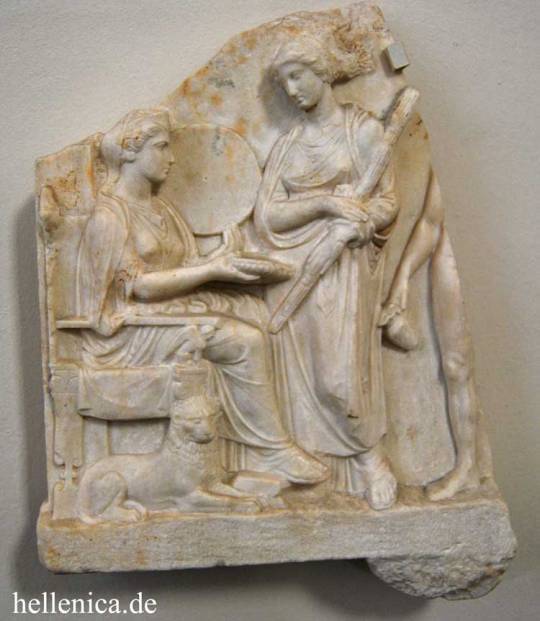
The deity whose role was most likely the closest to Hecate's own before the negative associations made her little more than a boogeyman was Cybele. Iconography and surviving accounts of rituals to both of these figures bear many similarities, which is considered one of the strongest arguments in favor of Hecate being an Anatolian goddess adapted into the Greek pantheon due to contact between Greek colonist in Asia Minor with local inhabitants such as Carians. It's also worth noting that in Greece both Hecate and Cybele were generally worshiped at household shrines rather than official, large temples. Sometimes Hecate and Cybele were also depicted together, though it's generally agreed they were never conflated. It is still uncertain to what degree Hecate was associated with the underworld before becoming a goddess of witchcraft – some authors assume that she was already in part cthtonic as a Carian deity, while others assume she only started to fulfill this role due to the later witchcraft associations, or due to conflation with the goddess Enodia popular in Thessaly, who was depicted as a crossroad deity like Hecate and was associated with ghosts. Falsehood #3:Hecate was always depicted with animal heads While not entirely made up, this claim is rooted in the Argonautica Orphica, a text only written in the 5th or 6th century, and likely inspired by neoplatonic, gnostic and magical sources. A probable origin of animal-headed Hecate are Egyptian magical papyri, likely influenced by Greek perception of Egyptian religion, and to a large degree disconnected from worship of Hecate in, say, Caria or Phrygia. Earlier sources and art depict Hecate with a single, human, head on each body, as discussed above. The animal-headed image only developed when Hecate started to be perceived exclusively as a goddess of witchcraft and similar arts. However, even though that was always the perception of this deity in Roman sources and in most Greek ones from 5th century BC onward, a number of cult sites in Anatolia, for example the temple in Lagina, continued to venerate her under the regular guise, and one of the most prominent indications of a lasting devotion to her comes from Greco-Bactrian coinage depicting entirely human, single-headed and single-bodied Hecate with Zeus.
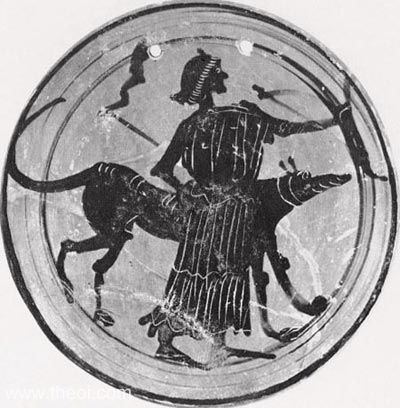
While Hecate was not depicted with animal heads before the dawn of Hellenic Egyptian magical papyri, from the very beginning she was associated with a number of animals, most importantly dogs, but also martens and polecats. Occasionally her animal companions were assumed to be humans cursed with such forms. While some versions of associated myths claimed Hecate cursed specific individuals (such as Gale or Hekuba) to live as animals, in others she instead took pity on victims of another deity's curse – for example, Antoninus Liberalis notes that it was believed that the polecat was a woman named Galinthias who was transformed into the animal by the Moirae and “Hekate felt sorry for this transformation of her appearance and appointed her a sacred servant of herself.” Occasionally Hecate was also depicted with lions, like Cybele and a variety of other Anatolian, Levantine and Mesopotamian goddesses. Falsehood #4: Statue of Liberty represents Hecate While the three falsehoods discussed earlier intersect and overlap, this one, as far as I can tell, developed separately, though it also was influenced by the idea of Hecate as a malevolent witchcraft goddess to a degree. Debunking it is much easier and doesn’t require any complex research – the Statue of Liberty was simply based on the personification of liberty depicted on the Great Seal of France:
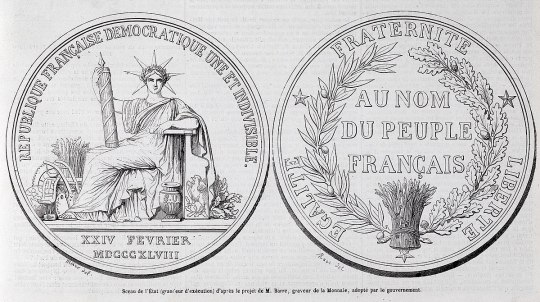
While Statue of Liberty's crown does resemble that worn by one of the three bodies of a famous statue of Hecate, currently displayed in the Vatican Museum, this style of crown was associated more with solar deities, especially the late Roman god Sol Invictus, and I have been unable to find any other depictions of Hecate wearing it.
Bibliography:
Fragments from a Catabasis Ritual in a Greek Magical Papyrus by Hans D. Betz
Hecate Cult ın Anatolia by Coşkun Daşbacak
Hecate: Her Role and Character in Greek Literature From Before Fifth Century B.C. by Carol M. Mooney; some arguments on the contrary can be found in Hecate: Greek or “Anatolian”? by William Berg
Theoi Hecate and Hecate cult pages - great source of quotations
COININDIA gallery of Agathocles’ coins
336 notes
·
View notes
Note
Hi! There is a question about the cult of the Greek gods I wanted to ask. Beyond the 12 Olympians plus Persephone and Dionysus, the other gods weren't given much attention or temples, right?
Oh no, they definitely were!
I think one of the big misconceptions people have about Hellenic polytheism is that it is functionally dodekatheism*, that is, the worship of twelve deities. The Twelve are portrayed as central to the religion, with all others being less significant or even forgotten. But this overlooks several elements of Ancient Greek cult.
The first is that, even in Antiquity, nobody could quite agree on who the Twelve were. Was Hestia among them? Was Dionysos? Was Herakles? A lot of the time, “the Twelve Olympians” weren’t even named; so this may have been more of an expression, a nice round number to designate the most important deities while leaving room for local interpretations of who was among them.
It’s certainly true that there are some deities who received more worship than others, and who are better known nowadays because of it. If I were to write an approximate list, it would be the following:
Zeus
Hera
Poseidon
Demeter
Hades
Hestia
Persephone
Hermes
Dionysos
Hephaistos
Athena
Ares
Artemis
Apollon
Aphrodite
Hekate
Herakles
Asklepios
Pan
You’ll notice immediately that there are far more than twelve - nineteen, in fact - and the list could be expanded even further to include deities like the Muses or Eros. My point here is that, while “the Twelve Olympians” was shorthand for the major Gods, to limit cultic importance to just twelve, or even to just Olympians, is disregarding the broadness of the Hellenic pantheon - and the fact that it is polytheism, not dodekatheism. The Ancient Greeks may have called on the Twelve when necessary**, but their worship included many more deities than that.
And this leads on to my second point: the Ancient Greek religion was not orthodox. Each city, town or even village had its own pantheon, composed of the major Olympians, locally important deities, like Aphrodite in Kythera or Artemis in Ephesos, and deities specific to the area, like nymphs and river Gods. This means that Sparta’s pantheon was not the same as Thebes’, Thebes’ pantheon was not the same as Corinth’s, and so on.
As a result, deities that were given minor importance in one place could be given major importance in another. Take Ares, for example: though he had a sanctuary in Athens, he didn’t play a particularly large rule in the local cult outside of war times - but he was highly worshipped in northern Greece. Other than deities, heroes also need to be taken into account: Helen and Menelaus were revered as Gods in Sparta (likely as the remnant of an early cult), though practically everywhere else they were viewed as human and not worshipped. So while it would be accurate to say that Athenians paid far more attention to the Twelve than to Helen, a Spartan would bristle at the thought!
To complicate things further, there’s the matter of epithets. Gods were worshipped under different aspects in different areas, and those aspects were sometimes so different that they blurred the line between “same God, different epithet” and “actually a different God”. For example, Apollon Smitheus was widely worshipped in Anatolia (modern Turkey), and his cult was full of native Anatolian elements. So while it would be factually true to say Apollon was important both in Delphi and in Anatolia, it would be missing the fact that Apollon Smintheus was not important in Delphi.
Lastly, the state cult wasn’t the only influence on how much a deity was worshipped. Circumstances also mattered: the Agathos Daimon was central to the household cult, a sailor might give special honours to Nereus, a pregnant woman might give most of her offerings to Eileithyia, and any individual could love a specific deity above others, like Hippolytos with Artemis. These may not have left as many traces as state-sponsored temples, but in everyday life, they were no less significant.
In conclusion, there was a concept of twelve particularly powerful and important deities, and it did somewhat correspond to which deities were worshipped most in practise, but reality was a lot more nuanced. Any God could be more or less important depending on who you were, where you were, and in which circumstances. Ultimately, the Hellenic cult was - and still is - as rich in variety as it was in deities.
*Some modern worshippers choose to call the religion Dodekatheism, which I’m not criticising. This isn’t about the term but about its interpretation as “worship of exactly twelve deities” being incorrect.
**Interesting anecdote: my professor recently remarked on the fact that, in the Homeric epics at least, only desperate prayers are addressed to “Zeus and the other Olympians”. People call on the Twelve when they don’t know to whom specifically to turn, and as a result, these prayers are the most likely to go unanswered.
705 notes
·
View notes
Text
Aphrodite’s dark side | Epithets
Evidence of a cult of a warrior and dark Aphrodite has been widely studied. Aphrodite had been depicted with armor and prayed to for martial assistance in many places from Syria, to Corinth, Sparta, Argos, the Attika, Kypris, Rome, Naxos, and many, many, other places (but mainly Sparta. Surprising, no?). The cult of a warrior Aphrodite has been suspected to have emerged from Aphrodite’s “ancestral” correspondents like Istar or Astarte, who were both goddesses of sex and war. However, the evidence of a dark face of Aphrodite is there, and it can be too called upon today, even if it wasn't as popular as her holy and hevenly aspects.
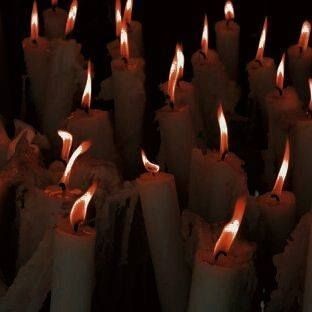
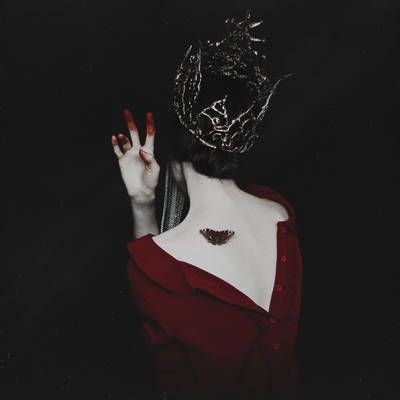
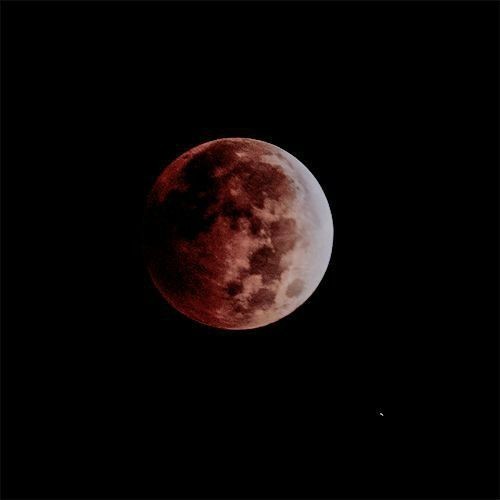
Enoplios — weapon bearing
This is an epithet of Aphrodite attested by Plutarch, and is also epigraphically present in the Roman period. In the third century AD a priestess, Ponponia Kallistoneiké, set up a dedication to Artemis Ortheia in Lakonia attesting one of her fellow deities was Aphrodite Enoplios.
Summakhia — ally in war
Pausanias finds a cult of Aphrodite “ally in war” in Arkadia. This is all the comment I could find about it.
Nikephoros — victory bearer
In Argos, according to Pausanias, Aphrodite wore the epithet “victory-bearer”. Icons of Nikephoros and Hoplismene (armed) Aphrodite have been also attested in Syria and Eretria.
Areia — of Ares / war-like
At Sparta mainly, there is a lot of evidence of icons portraying an armed Aphrodite with inscriptions of this epithet. Pausanias tells us of one in a temple behind the Bronze House of Athena. There is another female wearing a peplos, a helmet and a spear, but without the aegis that characterizes Athena, thus many suspect it belongs to an armed Aphrodite.
HOWEVER Leonidas of Tarentum writes in the third century: “Eurotas once said to Kypris (Aphrodite), ‘Either take up arms, or quit Sparta, the polis mad for arms.’ She, laughing, replied, ‘I shall be ever unarmed.’ She said ‘and I shall dwell in Lakedaimonia.’ Our Kypris is unarmed. Shameful are those tale-tellers who say that our goddess bears arms!”
BUT from Antipater of Sidon, in the first century, there is a contradiction: “Even Kypris is Spartan. She is not dressed as in other towns in soft garments; But in full-force she has a helmet instead of a veil, instead of golden branches a spear-shaft. For it is not proper for her to be without arms, the consort of Thracian Enyalios (Ares) and a Lakedaimonian.” And this is not the only record we have of an actual Aphrodite wearing armor in Sparta; Plutarch, Nonnos, Julianus of Egypt and perhaps others tell us about the Spartan tendency to portray Aphrodite wearing an armor; either bow and quiver, spear and helmet, a shield, and even a sword. So perhaps Leonidas was either being sarcastic or lying (or the cult of Aphrodite Areia came after him, of course). This Epithet is thus related to Hoplismene. Julianus tells us that in the sanctuaries of armed Aphrodite girls revere her war-like nature and women give birth to courageous children.
Above all, Pausanias also claims that this Aphrodite was specifically worshipped as a female Ares. This gives us a clue whether this Aphrodite had been syncretized with Ares’ actual femenine counterpart, Enyo (Ares has an epithet related to her: Enyalios)
Androphonos — killer of men
This epithet is representative of her chthonic aspect. There is evidence of a sanctuary of hers and Aphrodite Anosia in Thessaly.
Anosia — the unholy
Aphrodite Anossia apparently was celebrated by women in Thessaly, and she is associated with homosexuality (although this is doubtful). Atheneus tells us a tale of a hetaira (courtesan) named Lais, that flee to Thessaly and fell in love with a man. A band of jealous women beat her to death at Aphrodite’s temple and thus the goddess in this temple became known as Anosia, the Unholy.
Tumborukhos — gravedigger
The Pythagoreans said there are two Aphrodites: one in heaven and one in the Underworld. Therefore she was called Tumborukhos as well.
Epitumbidia — she upon the graves
Couldn't find much information on this epithet either but it must be related to the previous one and representative of her Underworld connections.
Skotia — dark one
This epithet is referent of Aphrodite’s origins as a terrible goddess, and her associations with the planet venus, which were suppressed later by the pop cult (not the association with the planet, tho). This epithet appears to link her to the Erynies and Hekate, and may be referent of a “witch-star” (kakkab kassaptu in ancient Babylonian) nature. The lack of evidence for these type of epithets points at an unpopularity of them. It is important to highlight that some of them could be use against the goddess to give her a bad or “demonic” reputation in the christian sense so I suspect their suppression might have a relation to that.
Melanis — black
Related to the previous epithet. It appears that these “dark” and “unholy” aspects of her are related to the planet venus, as points her Ouraneia (“heavenly”) epithet as well. Venus was known as a “star of lamentation”.
Persephaessa — Queen of the Underworld
This epithet appears to be a syncretism between Aphrodite and Persephone. This is obviously mainly an epithet of Persephone. I could not find evidence for it being used to Aphrodite in the ancient world, just commentaries about it; however, by searching it on google you find an archeological source of it but sadly its written in german, and I have no idea how to read german.
Hoplismene — armed
Pausanias tells us about the sanctuary of Aphrodite at Kythera, saying that there “the goddess herself is an armed xoanon”. The xoanon were archaic wooden icons, and this one, according to Pausanias, was wearing an armor. Quintilian once asked why the Lakedaimonians (Spartans) have an armed Aphrodite, and Plutarch said that they like to portray every god in armor to show that all of them have excellence in warfare. This Aphrodite is present in Corinth as well.
Hegemone — leader (of the troops)
This Epithet of Aphrodite is found in the Athenian Agora, and their border fortress at Rhamnous. The city council also offered dedications to this Aphrodite. There are figures of her engaged in combat with the giant Mimos, and other portrays Aphrodite in a chariot wearing Athena's aegis (although it lacks the gorgon face), along with Poseidon. Hesikhios confirmed this epithet in the sixth century AD saying it applies to Artemis as well. This Aphrodite was also offered sacrifices with Themis and Nemesis, in honor of Aeneas, her son.
Strateia — campaigner
In the Hellenistic period, Aphrodite was called Strateia in western Asia Minor. There is an inscription from Mylasa refers to a priest of Aphrodite Strateia, and a calendar of offerings specifies sacrificing to Aphrodite Strateia along with Arete and Herakles. In Paros and Epiros, strategoi (military generals) are known to have sacrificed to Aphrodite, along with other deities.
Enkheios — spear-bearer
Hesikhios, an author from the 6th century AD, tells us about a terracotta Aphrodite in Cyprus depicted holding a helmet in one hand, a spear, and a shield leaning against one of her legs.

Conclusions
Can we use these aspects of Aphrodite even if they have been exaggerated and weren't actually very much present in ancient cult? Of course. Because worship changes and evolves, if you find one of these epithets symbolic in your life and devotion, you can totally use them and even give them a different dimension. As a witch, for example, I could use the dark and unholy epithets of Aphrodite as a symbol of how witchcraft has been regarded as evil in superstition and a reminder of the persecution women have gone through, and it would be an act of devotion to the Goddess and an act of empowerment. The unpopularity of many of these epithets is also representative of stigma against women and thus using them today could be attested as an act of rebellion.
References
Stephanie L. Boudin, Aphrodite Enoplion
The Other Side of Aphrodite
William Manning, The Double Tradition of Aphrodite’s Birth and her Semitic Origins
Yulia Ustinova, The Supreme Gods of the Bosporan Kingdom: Celestial Aphrodite & the Most High God
Laura McClure, Courtesans at Tables: Gender and Greek Literary Culture in Athenaeus.
John Opsopaus, The Ancient Greek Esoteric Doctrine of the Elements: Water.
Aeon Journal, Aphrodite
#hellenic pagan#theoi#hellenic polytheism#aphroditedeity#hellenic polytheist#hellenic paganism#pagan#greek polytheism#aphrodite worship#aphrodite devotee#aphrodite offerings#greek myth#mythology#greek mythology#hellenismos
803 notes
·
View notes
Quote
Both Hekate and Hermes share the role of psychopomp and protector of the crossroads and by-ways of the mental and physical planes. ‘Herm’ posts often stood beside those of ‘Hectarea’, the Triple-Formed Hekate, complete with three heads and six arms. Popular myth present them as lovers or companions, as healers, patrons of Lunar energy and harbingers of death. Bridging the worlds, they reveal past, present and future simultaneously, bestowing prophetic visions and ancestral communication. From their shadowy twilight world of illusion their gifts of enchantment secure the rapture and bliss of their devotees. Another, less well known epithet of ‘Hekatos’, meaning – Distant One (the airborne magic that strikes its target), is one that Hekate (as a form of Artemis), shares with Apollo. Legends also tell of her as a phosphorescent angel, shining in the darkness of the Underworld, where her hypnotic light of trance-formation is revealed within the decaying mounds of the dead. Here her role merges with that of Persephone and Demeter, with whom she became associated within alternative Greek mythologies.
Shani Oates - Tubelo’s Green Fire
40 notes
·
View notes
Text
One Unique Epithet for Some Theoi
I need to make those epithet posts on my personal worship. Until then, here are these!
Zeus of the Flower Crown
(I’ve talked about that on a different blog a long while ago) I don’t know why, but the thought of Zeus wearing a flower crown really makes me feel... I’m not sure. Like it’s right. I can see one of His children coming up to Him, and giving it to him in place of a gilded laurel wreath, and Him graciously accepting it. I love it so much, it makes me feel like He ismy father and I can look to Him for love.
Hera of Chickadees
This is a long story, but basically, I was feeling really down, and a chickadee landed when I asked for a sign to keep going. I have always attributed it to Hera.
Aphrodite of Fluttering Wings
There is something so soft and beautiful about the fluttering of wings. I immediately think of a dove, just stretching and waving its little wings. So sweet.
Athene of New Beginnings
Starting new things, especially skill/academic things, is super hard. I feel that Athene is a goddess of pursuance towards excellence, and definitely someone that could help push you to go farther, to get even better, and do what you have the ability to.
Hermes of Collections
I think He would like bits and bobs and odds and ends, so naturally, He could be a collector. I have a few collections (crystals, knick knacks, etc) and I always feel like He enjoys them with me.
Apollon of Sideways Smiles
I picture Apollon as a somewhat serious Theos, however, I do think He smiles. And when He does, it must be so awesome, so gorgeous. And I also feel that it’s sideways, a little quirky.
Artemis of Forgotten Tasks
I doubt Artemis looses her focus for very long, being a Huntress, and a protector. So I look to Her when I think I have forgotten something, or need help remembering an item on my to-do-list.
Hestia of Laundry Detergent
My whole house smells like Gain. I swear by it. It reminds me of home, and thus it reminds me of Hestia. Everything about the smell screams ‘family’ to me.
Dionysos of Syrup
There is so much sweetness in syrup. It’s like wine, but for people that don’t drink (not really, but y’know). I associate it with Him because it’s so rich and honestly, eating it is euphoric.
Poseidon of Sturdy Walls
He is the Theos of Earthquakes, is He not? I feel that He has definitely influenced builders and their ability to create strong foundations and earthquake-proof buildings. But that’s just me.
Hephaistos of Stone-Cutters
Like granite. I walked into a granite selling place, and it totally reminded me of Hephaistos. The way it looked, all dusty and full of potential, and the sounds, even. It was a really cool place.
Ares of the Children
I feel like Ares’ fighting spirit was definitely instilled in some children. Their strong will, combined with passionate emotions reminds me of Ares. I love it, seeing His influence at work. It isn’t a bad thing. It’s an interesting thing.
Demeter of Long Hugs
Okay but can’t you see Demeter holding Persephone in Her arms, reluctant to let go? I sure can. So I associate Demeter with long hugs, especially from parents or guardians or awesome people in general.
Hekate of Surreal Places
I don’t know why, but crossroads have always been super weird to me. You have a choice, and you must make it to continue. That’s surreal, and so are other spots. I say Hekate instills some of Her power in those place.
My Posts for Haides and Persephone.
304 notes
·
View notes
Text
List of deities I want to work with!
Goddesses:
•Aradia- Italian folkloric figure described at the Gospel of Witches by Charles Leland. She is the daughter of Diana and Lucifer and she descends to the Earth to teach witchcraft to the poor masses who are defenceless against the oppression of christianity.
•Artemis Diana (I dont seperate them)- Grecoroman deity. Goddess of the Moon, hunting and wild animals. She is a virgin/maiden goddess and the twin sister of Apolo. Also known as Phoebe
•Hekate- Titan Goddess of witchcraft, crossroads, ghosts and apparitions. She is also a moon goddess. She is part of the train of Persephone among the kakodaimones (evil daemons). She and Artemis share the epithet Kourotrophos (taking care, raising children). Her symbols are the hounds, keys, snakes, daggers, torches, bulls and horses. She is also called trimorphe (she is a triple goddess herself)
•Demeter- Mother of Persephone/Kore. She is a mother and earth goddess and a goddess of agriculture. She brings the seasons when Persephone returns to her(spring, summer) or leaves her (autumn, winter).
•Persephone- Daughter of Demeter, wife of Hades, Queen of the Underworld, Goddess of Spring, flowers and fertility
•Gaia- the All Mother (Gaia Pammetor), the mother of all living things and of all the Gods. The Earth Goddess, Mother Nature
•Rhea-Cybelle- Titan Goddess of the earth and fertility, wife of Kronos and Mother of Zeus.
•Selene- The moon herself envisioned as a goddess. She is the lover of Endymion with who she had over 50 offsprings. Pan tricked her that he was Endymion and seduced her.
•Aphrodite- Goddess of love, beauty, sex, pleasure, lust, war, persuasion and democracy.
•Hestia- Goddess of the Hearth. Every fire in a household is sacred to her and all altars are her altars whatever the god the altar is dedicated to. She is protecting you sacred space and your home.
•Freya- Norse Goddess. I dont know much about Freya yet other that either her or Frigga gave the name to the day friday. I think she is a love goddess and an earth goddess. Her brother is Freyr. I think she takes some of the heroes that die in battle while others go to Valhalah. *to all the Norse pagans who may see this please correct me if Im wrong*
•The Morrighan- Celtic goddess of war and death. She is a triune goddess as well. Her sacred animal is the raven.
•Ceridwen- Celtic Goddess of magic. A mother goddess. I know her myth but im not pretty sure about the names so I will update it later.
•Isis- or Aset. Goddess of magick death and rebirth. She is the mother of Horus and the wife of Osiris, who was murdered by his brother Set. She brought him back to life by connecting his shuttered body parts.
•Lilith- Dark goddess of storms, sex, sexual lust and witchcraft. She is the first wife of Adam and a feminist figure. She was casted away from Paradise for wanting to be equal with Adam while having sex. She is also considered a succubus.
•The Green Woman- a Wiccan deity/figure/spirit. She is the representation of Nature and the fertile earth. Concort of the Green Man.
•The Star Goddess- an Important figure in the Feri (Faery) Tradition of Witchcraft (not to be mistaken as fairy wicca/witchcraft). She is a hermaphrodite deity. She is called the God Herself. She is the creator of everything. She gave birth to the devine twins, who were her conscorts until she took them back inside her ans rebirth them as the Blue/Peacock god.
Gods:
•Cain/Qayin- biblical figure revered in qayanite traditions of witchcraft, the Sabbatic craft (cultus sabbati), the American folkoric witchcraft etc. He is the first murderer, the creator of civilization, he is god of the Green kingdom and of Death. He is the Black man, the Devil at the crossroads.
•Apollo Karneios- Greek god of the sun, poetry, music, the arts and divination. Karneios is an epithet of him. As Karneios he is depicted with goat or ram horns. He is the twin brother of Artemis.
•Pan- Satyr god of nature, the wilderness, shepherds, flocks and domestic animals, sex and lust. He is a wild God always with an erection, a part of the train of Dionysus. His father is Hermes. He seduced a lot of Nymphs and has many male lovers calked eromenoi (he is PANsexual!!!)
•Dionysus Kerasforos- He is the god of wine and vines, sex, orgies and madness. He is a cthonic god. He is flamboyant and often dresses with female clothing(kerasphoros means he has horns)
•Hades- God of the underworld, judge of the souls of the dead. Husband of Persephone and brother of Zeus.
•Ouranus- Primordial god of the Sky. Also a Father god. He is the concort of Gaia.
•Kronus- Titan and cthonic god of Time and sky. He ate his children except Zeus.
•Helios- he is the Sun envisioned as a god. He rides his chariot at the sky from dawn till dusk.
•Hermes- the messenger of the gods and of humans. God of sex and lust and fertility( he sometimes is depicted with an enormous phallus), he is a psychopomp guiding the souls to the underworld. He is also a trickster god and patron of thieves and beguilers. He is the link between the Sky and Gods, the earth and humans, and the Underworld with its dead.
•Wodan (Wotan, Woden, Odin)- Norse god. King of the gods. He is a Sky god and a god of death. He is in charge of the wild hunt. He holds every knowledge and he is wise. His wife is Frigga. He takes some of the heroes who died glorious in battle to reside with him in Valhala. (Same with Freya I dont know a lot so correct me)
•Cernunnos- Celtic god of the wild. He is depicted with stag horns. He is protectir of the wild animals and of nature. If he is depicted with an errect phallus he is also a god of fertility.
•Bucca- a fae in cornish folklore and a deity in Cornish Traditional witchcraft. Bucca is similar to the fugure of Baphomet. A hermaphrodite god with goat characteristics. God of witches. The Devil at the crossroads.
•Lucifer- the fallen angel, the rising star. A rebel. God of light, the sun and knowledge. Concort of Lilith. A deity revered in Luciferianism and Luciferian witchcraft.
•The Green Man- a Wiccan deity/figure/spirit. A personification of Nature and the wilderness and a deity of fertility.
•The Blue God- a major deity in the Feri Tradition of Witchcraft. Concort of the Star Goddess. He merged from the union of the devine twins. He is also hermaphrodite and a flamboyant and ambiguous figure
•Baphomet- a deity presented first from Eliphas Levi as the Goar of Mendes. Baphomet is a symbol of the great creator. A hermaphrodite deity full of duality and everything that makes the world.
33 deities till now and I believe more will come it the future…..
*Note that with most of this deities I havent established a deeper connection or dont know everything about them yet in great depth. Correct me if Im wrong but please be kind. I will update this as soon I have more experience with all of them*
13 notes
·
View notes
Text
Epithets: Nekyia, Nekuia
Nekyia/Nekuia
Mistress of Corpses, of the Underworld, of the Rites of Ghosts.
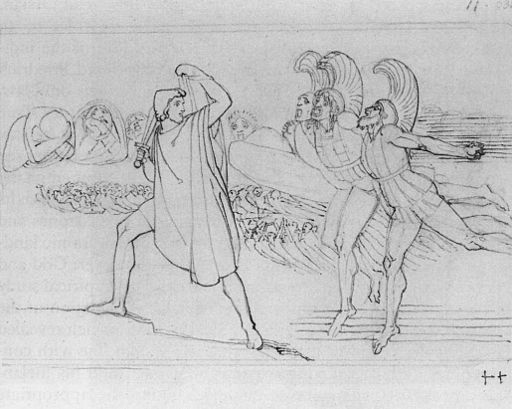
There once existed an arc of stories called the Nekyia, which focused on the Underworld journey of Odysseus, but it, with the exception of the Odyssey, and most of the art depicting its events are fragmentary. Theseus too had his Nekyia, as did Orpheus. Most interestingly to me, we know that one Nekyia mentioned the family origin of Iphimedeia, a figure who may be the same as Iphigeneia, said to have been transformed in to Hekate by Artemis.
The Nekyia is full of stories of eternal punishment. Here we see Sysiphus with is boulder among the other famous persons guilty of various crimes. It seems apparent that the storytellers and artists who communicated the story were free to change the characters of the arc in order to best suit their audience or their patrons. Thus the Gods present and the particular crimes of the background characters were altered for political and social purposes as necessary. (This is true of many of the stories which have survived, and why we have some measure of variability between accounts.)
Ultimately however, it appears that the theme of the Nekyia was an initiatory one, suggesting elements of the process of being inducted into a Mystery Cult. As such the main character, whoever they might be, are described as heroic figures of virtue, and who, in the process of their traversing the Underworld, demonstrate their grasp of right action and right thought before the Judges of the Afterlife, Dareios, Xerxes, and Artaxerses. Their military victories are coached as moral victories, and heroic acts ennoble the person.

Nekyia can also refer to the rites of necromancy by which the dead were summoned for insight into the future, as well as the funereal rituals.
The name Nekyia has become a type for literature, in which the hero makes a journey through some symbolic underworld, and must strive for survival. It has even inspired Jungian archetypal insights.
All of which offers us some insight into why the PGM’s collaborators might have used the term to describe Hekate, that Goddess who spans all realms, but who, by the late antique era, had become largely understood as a Goddess of the Dead and Unwanted, of necromancers and cemeteries.
I call upon you, Mother of all men, /you who have brought together the limbs of Meliouchos, even Meliouchos himself, OROBASTRIA NEBOUTOSOUALETH, Entrapper, Mistress of corpses, Hermes, Hekate, [Hermes?], Hermekate, LETH AMOUMAMOUTERMYOR… - PGM III.1-164, lines, 45-49.
The term is also found in PGM IV.2708-84, where it is instead translated as “rite of ghosts”.
IO all-powerful goddess / and IO all-guarding one; IO all-sustaining One, ZELACHNA: and SAAD SABIOTHE NOUMILLON NATHOMEINA, always KEINETH, stalwart THESEUS ONYX, prudent DAMNAMENEUS, avenging goddess, strong goddess, rite of ghosts, Persia SEBARA AKRA. – PGM IV. 2708-84, lines 2775-2781.
Hekate is, of course, often a Goddess who helps the dead make the journey into the afterlife, and who welcomes those who would otherwise wander aimlessly. Her priestesses, in the surviving stories, summon the dead and put them to task, and many of the surviving spells invoking Hekate are buried in cemeteries in order to harness the powers of the dead. Nekuia strikes me as a very fitting name for our Goddess of Three Ways. Hail unto Hekate Nekuia! Let my words reach my Beloved Dead, In these rites.
Sources:
Betz, Hans Dieter. The Greek Magical Papyri in Translation: including the Demotic Spells, Chicago, 1996. Castriota, David. Myth, Ethos, and Actuality: Official Art in Fifth-century B.C. Athens, Wisconsin, 1992. Crowley, Vivianne. Jung: A Journey of Transformation: Exploring His Life and Experiencing His Ideas, Quest, 1999. Larson, Jennifer Lynn. Greek Heroine Cults, Wisconsin, 1995. Lyons, Deborah. Gender and Immortality: Heroines in Ancient Greek Myth and Cult, Princeton, 2014. Pike, David Lawrence. Passage Through Hell: Modernist Descents, Medieval Underworlds, Cornell, 1997. Rohde, Erwin. Psyche: The cult of Souls and the Belief in Immortality among the Greeks, Routledge, 2014. Smith, Evans Lansing. The Hero Journey in Literature: Parables of Poesis, Univ. Press of America, 1997.
Images:
Flaxman, John. “Odysseus in the Underworld,” pen illustration, 1792, now in the Royal Academy of Arts, via wikicommons: https://commons.wikimedia.org/wiki/File:John_Flaxman_-_Odysseus_in_the_Underworld_-_WGA07912.jpg
Swing Painter. “Nekyia: rancorous Ajax, Persephone supervising Sisyphus pushing his rock in the Underworld, side A,” photo by Bibi Saint-Pol, now in the German State Collection of Antiquities in Munich. Via wikicommons: https://commons.wikimedia.org/wiki/File:Nekyia_Staatliche_Antikensammlungen_1494_full.jpg
#Hekate#hecate#theoi#necromancy#witchcraft#nekyia#nekuia#house of hades#odysseus#theseus#orpheus#underworld journey#mystes#epithets
39 notes
·
View notes